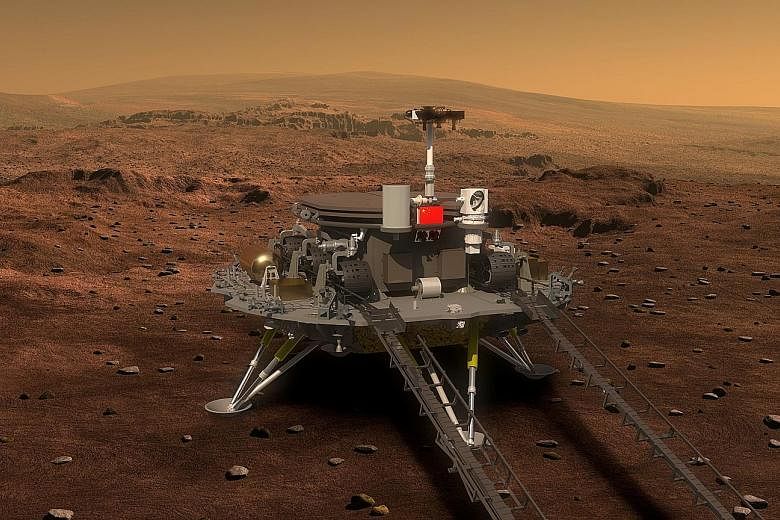BEIJING • China has unveiled illustrations of a Mars probe and rover it aims to send to the Red Planet at the end of the decade in a mission that faces "unprecedented" challenges, state media said yesterday.
China, which is pouring billions into its space programme and working to catch up with the United States and Europe, announced in April it aims to send a spacecraft "around 2020" to orbit Mars, land and deploy the rover.
Mr Zhang Rongqiao, chief architect of the project, said on Tuesday they were targeting July or August of that year for the launch, Xinhua news agency reported. "The challenges we face are unprecedented," he said.
A Long March-5 carrier rocket will be dispatched from the Wenchang space launch centre in the southern island province of Hai- nan, Xinhua said, citing Mr Ye Peijian, a mission consultant.
The lander will separate from the orbiter at the end of a journey of around seven months and touch down near the Martian equator, where the rover will explore the surface, it said. The 200kg rover has six wheels and four solar panels, and will operate for around 92 days, according to Chinese media reports.
It will carry 13 sets of equipment, including a remote sensing camera and a ground-penetrating radar to study the soil, environment and inner structure of Mars, and look for traces of water and ice, Xinhua said.
China has an ambitious military-run multibillion-dollar space programme that Beijing sees as symbolising the country's progress and a marker of its rising global stature.
China insists its programme is for peaceful purposes, but the US Defence Department has highlighted China's increasing space capabilities, saying it is pursuing activities aimed to prevent adversaries from using space-based assets in a crisis.
Apart from its civilian ambitions, Beijing has tested anti-satellite missiles, and the US Congress has banned the National Aeronautics and Space Administration from cooperating with its Chinese counterpart due to security concerns.
The nation's first lunar rover was launched in late 2013, and while it was beset by mechanical troubles, it far outlived its expected lifespan, finally shutting down this month.
But for the most part, China has replicated activities that the US and the former Soviet Union pioneered decades ago. It has already been beaten to Mars by Asian neighbour India, which put a low-cost probe into orbit around Mars in 2014. The US has landed two rovers on Mars, and the former Soviet Union and the European Space Agency have also sent missions to the planet.
China's first attempt to send a satellite into Mars orbit floundered in 2011 when the Russian rocket carrying the payload failed to make it out of the Earth's orbit.
AGENCE FRANCE-PRESSE, REUTERS

